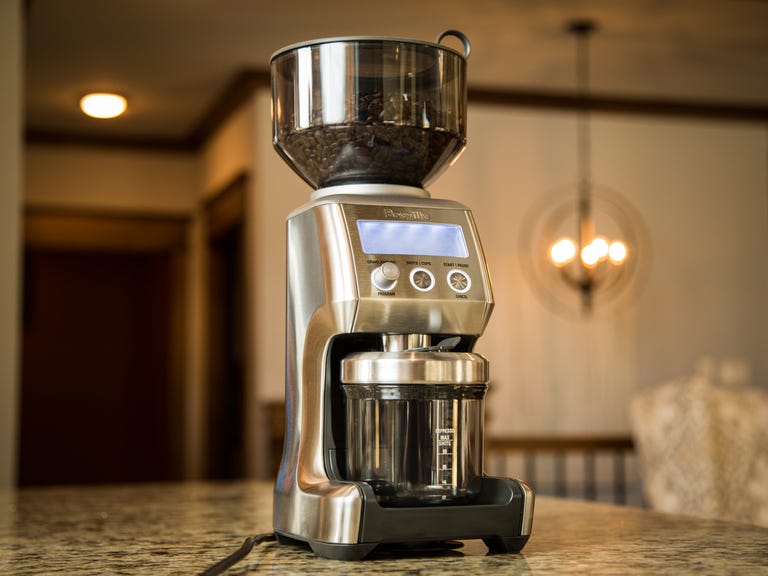 Why You Can Trust CNET
Why You Can Trust CNET Breville Smart Grinder Pro review: Breville's smart coffee grinder is best for single servings
Breville's Smart Grinder Pro works best with espresso makers and single cups of pour-over.
The $200 Breville Smart Grinder Pro (£160 in the UK, roughly AU$264 in Australia) coffee grinder uses steel burrs to crush beans into coffee grounds suitable for espresso, drip, cold brew and French press. Even so, it's expensive, complex to operate, and makes mistakes when grinding for pots of drip.
The Good
The Bad
The Bottom Line
The Smart Grinder Pro looks inviting enough with its attractive stainless steel body. It's compact as well and thanks to a grind container that locks into place care of magnets, the appliance doesn't make much of a mess. By comparison, both the $200 Oxo On Barista Brain Conical Burr Grinder and the $145 Baratza Encore tend to generate a noticeable amount of leftover coffee debris.
The Breville Smart Grinder offers a greater number of coarseness settings than those devices, too -- A total of 60 grind sizes compared with the Encore's 40 coarseness levels and Barista Brain's 15. Breville bundles a pair of cradles designed to accept two common sizes of espresso portafilters (50-54mm, 58mm) as well. If you own a home espresso machine, these adapters let you grind directly into their portafilters.
Choose how coarse or fine you want your grounds with the knob on grinder's left side.
The Smart Grinder Pro has no scale to measure how much it grinds. Instead it strives for consistent grind volume using a digital timer. For instance, at each coarseness setting, the grinder asks you to choose how much coffee you plan to make (listed in number of cups or espresso shots).
The last variable is grind time, a value the grinder displays in seconds on its LCD screen. Assuming a particular combination of grind time and grind size yields your preferred amount of coffee grounds, you can then program these settings into the machine's memory. In theory, after that you simply input the number of cups or shots of coffee you'd like and the grinder calculates the rest.
Choose grind parameters for grind time and number of cups or espresso shots.
In reality, I had mixed results. I successfully programmed the machine to supply 22 grams (just over three-quarters of an ounce) of grounds (number 55 coarseness for 11.2 seconds). That's my recommended amount of coffee to make a delicious cup of pour-over. Telling the grinder to grind for numerous cups produced enough grounds for each portion individually.
I ran into problems when I tried to grind a big batch of beans for a pot of drip. The Smart Grinder Pro doesn't have a dedicated setting for large grind jobs, so I punched in an order for 8 cups. It's the maximum volume many popular drip brewers make, such as the Bonavita BV1900TS and Technivorm Moccamaster KBT-741.
Using my preset to grind to this amount resulted in way too much coffee (about 180 grams, 6.4 ounces). That's almost three times what I recommend for a 40 ounce (1.2L) carafe of joe (66 grams, 2.3 ounces of coffee beans). Sure, you can set the grinder to provide the correct drip amount through trial and error. I also realized that if I ground to supply coffee for three cups, I ended up with precisely enough for a pot of drip. Essentially the machine created three times my single-cup measurement (22 grams). Of course both methods are workarounds, and less elegant than a dedicated carafe setting.
The Smart Grinder Pro does have a manual mode so you could weigh out beans separately, then grind them. Unfortunately, you have press the Start/Pause button continuously to engage the function. That makes the task a pain compared with flipping the Baratza Encore 's on-off switch. The Oxo Barista Brain grinder is easier to operate, too, since it stops automatically when the scale detects your target weight.
The Smart Grinder Pro's grounds container fits in place securely thanks to magnets.
All this leaves me cool on recommending the $200 Breville Smart Grinder Pro. I'd much rather pick up a cheap $20 kitchen scale and pair it with the $145 Baratza Encore. You'd always grind well with accuracy, and for less cash. Truly frugal shoppers willing to sweat can go with the $40 Bialetti Manual Grinder while those seeking convenience should select the $200 Oxo Barista Brain grinder and its built-in scale.


